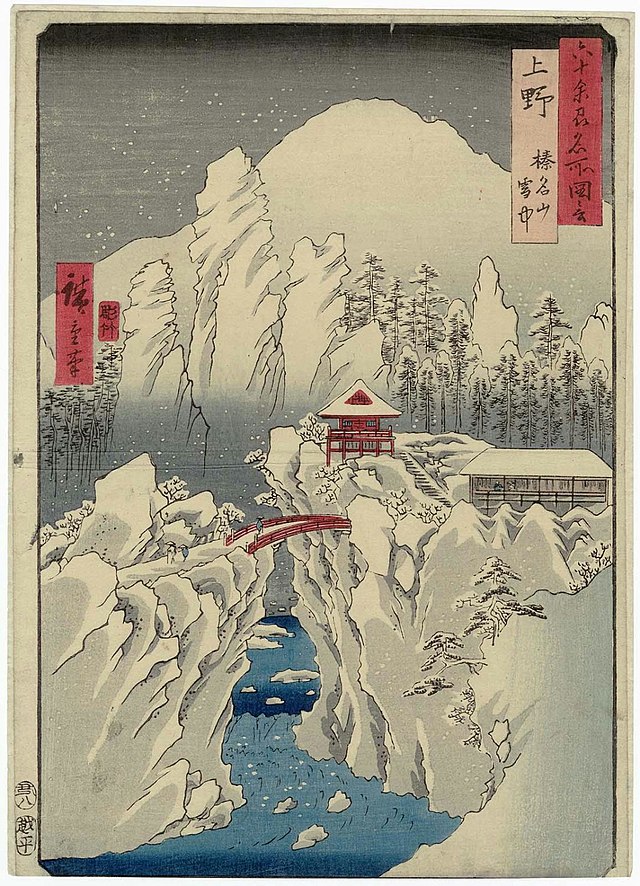Loading AI tools
Former province of Japan From Wikipedia, the free encyclopedia
Kōzuke Province (上野国, Kōzuke-no kuni) was a province of Japan in the area of Japan that is today Gunma Prefecture.[1] Kōzuke bordered Echigo, Shinano, Musashi and Shimotsuke Provinces. Its abbreviated form name was Jōshū (上州). Under the Engishiki classification system, Kōzuke was ranked as one of the 13 "great countries" (大国) in terms of importance, and one of the 30 "far countries" (遠国) in terms of distance from the imperial capital, Kyoto. The provincial capital is located in what is now the city of Maebashi; however, its exact location remains uncertain. The ichinomiya of the province is located in what is now the city of Tomioka.


During the 4th century AD, (Kofun period) the area of modern Gunma and Tochigi prefectures were known as Keno or Kenu (毛野), literally "hairy field", but used as ateji for 食野 or "food field" in reference to an imperial agricultural area.[2] At some unknown point in the 5th century, the area was divided at the Kinugawa River into Kamitsukeno (上毛野) ("Upper Keno") and Shimotsukeno (下毛野) ("Lower Keno"). Per the Nara period Taihō Code, these provinces became Kamitsukeno-no-kuni (上毛野国) and Shimotsukeno-no-kuni (下毛野国). At some point, the no meaning "field" was reanalyzed as the possessive particle no, resulting in shortened names (without the Kuni (国) or "province" portion) of Kamitsuke and Shimotsuke. In 713, with the standardization of province names into two kanji, these names became Kamitsuke (上野) and Shimotsuke (下野). Later regular sound changes caused Kamitsuke to shift to Kaudzuke, and then to modern Kōzuke.[2][3][4]
During the Heian period, from the year 811, Kōzuke (along with Hitachi and Kazusa) was one of the three provinces where an Imperial Prince was designated as nominal ruler. The area was noted for its production of horses. The original capital of the province was located in what is now Maebashi, along with the kokubun-ji and the sōja of the province. The ichinomiya was located in what is now the city of Tomioka.
During the Sengoku period, Kōzuke was contested between the later Hōjō clan, the Takeda and the Uesugi clans. After the establishment of the Tokugawa Shogunate, much of the province was assigned to several feudal domains. The Nakasendō and the Mikuni Kaidō highways passed through the province, and numerous post stations were established.
Following the Meiji restoration, the various domains became prefectures with the abolition of the han system in 1871. These various prefectures merged to form Gunma Prefecture in 1876. The area subsequently prospered with the development of sericulture and silk spinning industries.
| Name | type | daimyō | kokudaka | notes |
|---|---|---|---|---|
| Maebashi Domain | fudai | Matsudaira | 170,000 koku | |
| Takasaki Domain | fudai | Ōkochi-Matsudaira | 82,000 koku | |
| Tatebayashi Domain | fudai | Akimoto | 63,000 koku | |
| Numata Domain | fudai | Toki | 35,000 koku | |
| Annaka Domain | fudai | Itakura | 30,000 koku | |
| Obata Domain | fudai | Okudaira-Matsudaira | 20,000 koku | |
| Isesaki Domain | fudai | Sakai | 20,000 koku | |
| Yoshii Domain | shimpan | Takatsukasa | 12,000 koku | |
| Nanukaichi Domain | tozama | Maeda | 10,000 koku | |
Seamless Wikipedia browsing. On steroids.
Every time you click a link to Wikipedia, Wiktionary or Wikiquote in your browser's search results, it will show the modern Wikiwand interface.
Wikiwand extension is a five stars, simple, with minimum permission required to keep your browsing private, safe and transparent.